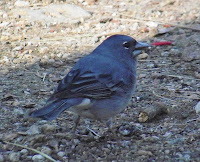So I can tell you have literally
been on the edge of your seat since reading my last blog post about my Tenerife
trip. Well fear no more, this is the rest of my trip, here is part 2......
Day Three
- Anaga Cloud Forest
 |
| Anaga Cloud Forest |
For this
day we travelled to the north-east corner of Tenerife to the Anaga Cloud
Forest. This habitat is a relic of a habitats that,
millions of years ago,
was widespread across the Mediterranean basin. Today
is found on Tenerife scattered across the island, only covering around
10% of its original area due to conversion to agriculture.
Despite this it’s still an amazing habitat.
We were
undertaking a vegetation survey looking at how the types
of vegetation changed with altitude. The range and size of
some of the plants was incredible, there were heather plants the size of trees
(unsurprisingly called tree-heathers) and huge ferns. The forests are
almost always covered b clouds, of course when I was there it was clear. The
conditions arise when the warm trade winds blow onto the island and the air
rises when it hits Mount Teide, as it cools it form a layer of cloud that these
plants exploit. A truly amazing ecosystem.
Of course
I was looking out for birds. The day stared well with several Canary Island
Chiffchaff (Phylloscopus canariensis) in the
tress around however my main
target species for the day were two near-endemic pigeon species:
Bolle's Pigeon (Columba bollii) and Laurel Pigeon (Columba junoniae). I was very lucky and saw them both, I only had
fleeting views however I was able to identify them by there distinctive tail
patterns.
 |
| Bolle's Pigeon (2a and 2b) and Laurel Pigeon (3a and 3b) |
Day Four - Lizard Population Monitoring at El Medano
 |
| The Tenerife Gecko |
Today was good fun, we spent the day trapping (and
releasing) lizards to look at their populations and also
temperature data. The site we went to had two lizard species: Southern
Tenerife lizard (Gallotia galloti galloti) and Tenerife Gecko (Tarentola
delalandii) both endemic to
the island. We caught the Southern Tenerife lizards in bottle traps and
the Tenerife Geckos were found by searching under rocks.
This reflects the different lifestyles with
the Southern Tenerife lizard being active in the day and
the gecko being nocturnal. Once caught the lizards body size, internal and
external temperature were taken as well the substrate and
air temperate.
After analysing the results it was found that the larger
lizards came out later in the day, when it was warmer, this was expected. The
data also showed the Southern
Tenerife lizard actively maintained a constant body temperature throughout the
day, by moving in and out of the sunlight whereas the geckos were able to
function at any body temperature. Bird life was fairly thin on the ground,
however good numbers of Spectacled Warbler (Sylvia
conspicillata) were seen and I saw a single Spanish Sparrow (Passer
hispaniolensis) in
the town afterwards.
Day Five
- ITER Wind Farm
 |
| The Muscovy Ducklings that were swimming around, not something I've seen before in January |
So, day
five the final day. Today we travel to the ITER wind farm in the south of the
island. ITER is a research facility for sustainable and renewable energy,
mainly wind and solar power. The work that is being undertaken here is
brilliant. There isn’t much more I can say as I’m no expert when it comes to
renewables, but if you want to know more their click here for their website. In
terms of birds all I saw were some captive Muscovy duck, but there were some rather
sweet ducklings swimming around.
Now I’m not massively sentimental,
but I will say this. We spent most of the week looking at geology and how the
past event on the island have affected the habitats and species found across
the island. It seemed fitting to finish with a day looking forward at the future
of Tenerife and indeed the world.
The Week in Birding
So I have been giving you little
updates on the birds seen each day. I can say it was a very good week of
birdwatching, especially considering that it was not actually a birding
holiday. I managed to see pretty much all my target species and all the endemic
and near-endemic species. Below is the full bird list, obly 21 species but its
quality not quantity:
| 1 | Kestrel | Falco tinnunculus |
| 2 | Feral Pigeon/Rock Dove | Columba livia |
| 3 | Bolle's Pigeon | Columba bollii |
| 4 | Laurel Pigeon | Columba junoniae |
| 5 | Collared Dove | Streptopelia decaocto |
| 6 | Pallis Swift | Apus pallidus |
| 7 | Common Swift | Apus apus |
| 8 | Great-Spotted Woodpecker | Dendrocopos major |
| 9 | Grey Wagtail | Motacilla cinerea |
| 10 | Berthelots Pipit | Anthus berthelotii |
| 11 | Blackbird | Turdus merula |
| 12 | Canary Island Chiffchaff | Phylloscopus canariensis |
| 13 | Tenerife Kinglet | Regulus (regulus) teneriffae |
| 14 | African Blue Tit | Cyanistes teneriffae |
| 15 | Spanish Sparrow | Passer hispaniolensis |
| 16 | House Sparrow | Passer domesticus |
| 17 | Chaffinch | Fringilla coelebs |
| 18 | Blue Chaffinch | Fringilla teydea |
| 19 | European Canary | Serinus canaria |
| 20 | Serin | Serinus serinus |
| 21 | Goldfinch | Carduelis carduelis |
| 22 | Southern Grey Shrike | Lanius meridionalis |







